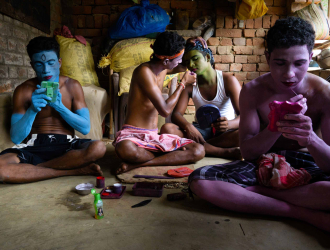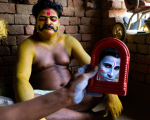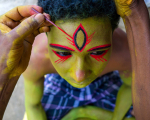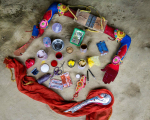Bahurupis are nomadic people who once travelled the length and breadth of the Indian subcontinent and performed in public spaces. Among the oldest performers of social entertainment in India, bahurupis, who are experts in disguise, often acted as spies for kings.
Bahurupi literally means a person who has many (bahu) forms (rupa). They achieve bodily transformation through a combination of make-up, body paint, masks, costumes, prosthetics, wigs and jewellery. Much like theatre actors, their physical transformation involves imitation of body language, mimicry, dance moves and exaggerated gestures. However, the bahurupis never perform on stage.
I was interested in documenting the daily life of the bahurupi community living in Bishaypur village, Birbhum district, West Bengal. Bishaypur is located about 50 km from Bolpur town, and is home to eight families of performers. They belong to the Bediya tribe, a Scheduled Tribe settled in the eastern and northern parts of India.
In earlier times, the Bediyas were hunters, moving around the forests adjoining Mayurakshi River, catching birds with traps and nets and selling them in local markets as pets. As a tribe considered low in the social hierarchy, the Bediyas were denied occupations like farming, weaving, and crafts. Later, when forest laws were enacted, the Bediyas were forced to abandon their traditional hunting practices. This was similar to the treatment meted out to the other marginalised communities of the time. Due to multiple restrictions, legal and social, they had to invent alternative livelihoods as snake charmers, herbal medicine sellers, monkey charmers, bear dancers, and other itinerant professions.
Around this time, about 80 years ago, a Bediya man who was employed as a guard at a zamindar’s house, witnessed a stage performance by a noti (a trained actor). Much like the bahurupi, the noti’s performance was a solo act with several makeovers. The Bediya guard was fascinated by the performance, and taught it to other members of his close-knit community. Eventually, the bahurupi tradition emerged. That camaraderie is still visible in how bahurupis help each other even now in dressing up. Bahurupi performers are often members of an extended family.
Regardless of how they entered the profession or which region of the country they belong to, their work culture is similar everywhere. In their disguised form they visit villages, pilgrimages and fairs, entertaining people with their dramatic performances, storytelling skills and expert mimicry. The villagers, in turn, reward the bahurupis with money or by donating food and clothes. This symbiotic relationship between the performers and the audience, the common people, is essential to the survival of the profession.
The bahurupi community of Bishaypur still practice the art frequently, if not daily, going out to neighbouring villages dressed up as mythical and historical characters or as animals. These days, they are also invited to perform in festivals for tourists and at wedding ceremonies.
The bahurupis are witty and streetwise. They entertain their audience in various ways— frightening, teasing or chasing them around, or performing a mock fight. The audience applaud and appreciate their sense of humour and unpredictable behaviour.
Their art form now has a cultural identity; it is not merely a means of livelihood. Yet, the social status of these artists remains precarious. In Bishaypur, their houses are built on the northern fringes of the village, indicating a clear demarcation. They are addressed as ‘gamar’, which in local dialect translates to ‘the others’. The Bediya people have always been aware of this discrimination and the dynamics of the caste system. When they are invited to other villages, bahurupis are not allowed inside homes, unless it belongs to a low-caste family. Upper-caste families denounce the Bediya community as untouchables. However, during their performances, their transformation into gods and goddesses seems to reduce the caste barriers momentarily. People interact and seek blessings from the avatars, even if they do not see the actual individual as an equal.
Over the past seven decades, performing as a bahurupi was the sole livelihood of the Bediyas. Only recently have the people of the community started taking up stable jobs and leading a relatively sedentary life. Bahurupi performances are physically demanding but the income they earn justifies neither the effort nor the time invested. Like everyone else, the bahurupis too want their children to go to schools, get proper college education and an upwardly mobile career.
Without the younger generation engaging in the profession, the future of the bahurupi performance is endangered. Faced with the rising cost of living, the new-generation Bediyas are reluctant about continuing the tradition, and in the near future, without outside support, they might have to forsake it entirely. The community urgently needs support from outside to ensure that the rich bahurupiya culture continues.
Names of bahurupis interviewed for the photoessay are: Ram Chowdhury Byadh, Bibek Chowdhury Byadh, Prabir Biittar, Prahlad Bittar, Basudeb Chowdhury Byadh, Barun Das Byadh, Nonichura Chowdhury Byadh, Shyam Sundar Chowdhury Byadh, Tarak Chowdhury Byadh, Sanatan Chowdhury Byadh, Raju Byadh, Bhanu Chowdhury Byadh, Dipak Chowdhury Byadh, and Soura Bittar.

















